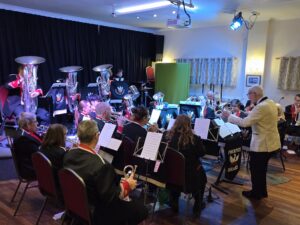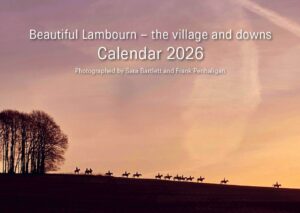An extract from “Tales of Berkshire” by Cecilia Millson reproduced by kind permission of Countryside Books. To purchase the book click here.

To travel by air, land, and water may be an east achievement nowadays but at the beginning of the seventeenth century it seemed but a fantastic dream. Yet men tried again and again to bring that dream to reality. William Bush was one man who succeeded for “by his cunning and skill Mathematique and Geometrical” he designed a small boat of the pinnace class, which he constructed very carefully with his own hands, allowing no other man to help him. In this vessel he managed to travel by air, land, and water from Lambourn to the Customs House Quay in London, and we are indebted to his friend “A.N.” who recorded in detail the exploits of the gallant inventor.
On the morning of Monday, the twentieth day of July, 1607, William Bush brought forth his masterpiece from the house of his friend, William Essex, Esquire, of Lambourn. What he had not taken into account was the enthusiasm of hundreds of people who waited to greet him. The news of the elaborate preparations in the churchyard had been carried far and wide. Surrounding farms must have been devoid of labour, markets deserted, and cottages empty if “A.N.” has not exaggerated the numbers who were present on that day.
Many had never seen a boat before and they gazed in wonder at the little pinnace, complete with oars and “four mastes and yardes of the most fine light timber that might be had or procured”. That was not all, “she had twelve pieces of Ordinance in her, that went off by a strange device in just order, one after the other; they were planted on a platforme framed for that, purpose uppon the Tower-decks in their equal proportions, and no man neere them at their discharging”.
To say that the ship was dressed overall is to underestimate the enthusiasm of her owner; she carried “flagges, auncients, streamers, and pendents of rich Taffetie, the colours sable and argent, according to the colours of him that made and framed her; her several flagges were beautified with divers Coates of Armes. as the Armes of England. the Essex coate, the Harcourts, and the Wayne mans: and the coate of the Shippewright, and his ancestors, with divers other Gentlemen of worthe, and worship in that country. . .”
A stout platform had been built on top of the tall tower of Lambourn Church; another in the churchyard below “fastened deepe in the earth with windlasses and other Engins to stain the ropes and assist the Pynace in moving by other devices”.
Two strong cables, nearly sixty five yards in length and weighing one hundredweight each were fastened to the tower platform “with windlass and other devices in it”.
The cables ran down one hundred feet apart (the width of the pinnace) and were secured to two stout trees. So when all was set in motion, the pinnace could be persuaded “to move by degrees, either ascending or descending”.
William Bush certainly deserved every jot of admiration which, was bestowed upon him by his friends – all that effort for a journey of “three score yardes”.
The intense interest of the crowd was to prove a hinderance to the eager traveller. Nearly an hour passed before the pinnace could be brought to the ground pIatform settled upon the cables, but soon she was ready to begin her ascent to the top of the tower. No one was aboard for that first voyage and as the little boat descended gasps of astonishment greeted the firing of her guns and the display of fireworks and other strange devices, for there was nobody within twenty feet of her to set these wonders in motion.
It was hoped that the free display would satisfy the people, for William Bush planned to start his real voyage l g the next day. However, the crowds refused to disperse and demanded to see a man aboard. William Bush, fearing damage to his craft went on board himself, and once again the pinnace was airborne, to the satisfaction of the two thousand people below. It was nearly six o’clock when the air-boat was returned to the safety of Mr. Essex’ garden.
If Mr. Bush thought to slip away quietly the next morning he was sadly mistaken. The crowd was greater than before, which is proof that it was possible to take two days off from work in those bad old days! It took twenty men to force a passage through the crowd and to set it up on the launching platform. Forty feet in the air she was suspended, out of harm’s way, while the inventor checked that all was in order. Then the boat was brought down and he ascended to the top of the tower, but one danger he had not foreseen. Unbeknown to him, some seventy men, women, and children had climbed the tower to gain a viewpoint from the roof. They clung to the pinnacles, the ropes, the pullies, even to the iron bracket of the weather vane, and they disregarded all danger in order to see the ascent of the pinnace. The extra weight took its toll. As the boat started to move with her commander on board, the two wain pinnaces fell down into the tower amongst the people who were standing there. By a miracle no one was hurt by the falling masonry. Panic reigned until someone had the forethought to call from the tower that all were safe, but the accident brought the foolish people hurrying down to ground level.
William Bush, having given thanks to God for the safe deliverance of the people, left his boat and went into the tower to see if any equipment had been damaged. He was satisfied that all was well and prepared to embark again in spite of pleas from his friends to remain safely on the ground. He pointed out that in truth God was with him on the adventure and with a cheerful countenance was hauled to the top of the tower. He gravely saluted his friends and then “by his owne industrie and labour let himself downe by degrees to the ground to the joy and wonder of all the beholders”. The journey by air was safely accomplished. Now the journey by land must commence and the boat was put on “wheels and divers other Engyns” which were placed in readiness at the lower end of the ropes. Having made ready, Mr. Bush sat in his wonderful machine and passed to and fro in the Churchyard to see that all was well appointed for his journey. He travelled only to his friend’s house that night for he was vexed and troubled by the hindrance of the crowd and was persuaded to rest before pursuing his journey.
Between four and five o’clock on Wednesday afternoon he was finally prepared and travelled from Lambourn to Up-Lambourn, a distance of roughly a quarter of a mile. As it was then seven o’clock in the evening he ceased his labours for that day and rested the whole of Thursday, setting out again on Friday afternoon.
He needed to be well refreshed for he had to ascend “an exceeding high hill towards Childerie downes, which he could very hardly attain the top of, but with great enforce-ment of paines and labour”. Downhill was easy and so overjoyed was Mr. Bush that he mistakenly attempted the ascent of another steep incline. This almost proved too much for him, but, having conquered it, he left his boat under guard and returned to Lambourn for a night’s rest.
Recovered, he rejoined the boat and went from Childrey Downs to the lodge of Sir Edmond fettiplace on Saturday. There is no mention of any travel on Sunday, but on Monday he covered a distance of five miles and reached Carmislow Hill. His progress the next day was disappointing. An important key by which the pinnacle was guided and governed broke suddenly and reduced the distance to only one mile but he achieved five miles again on Wednesday, reaching Aldworth. He concluded his journey coming to Streatley on Thames, on Thursday.
Now came the final test. Mr. Bush watched anxiously as his boat settled on the water but she stood the test having been “very carefully calked and pitched to keep the water forth”, All seemed well, but now the worst misadventure of the journey befell poor William Bush.
A gang of bargemen waded into the water and started to destroy the strange craft. In vain they were entreated to stop their vandalism. They responded to the pleas with abuse and coarse laughter. Mr. Bush and his two companions were hopelessly outnumbered. Although the commander was unhurt his attendants were badly injured and to save their lives he removed them to the safety of their lodgings, leaving his precious boat to the mercy of the ruffians. Maliciously they rent her with pike staves and long hooks until they thought the little pinnace was damaged beyond repair, but they had reckoned without the courage and indomitable spirit of William Bush.
He mended his craft and on August 19th he set course for London where he arrived safely at the Customs Quay and was greeted by the Customer, Controller, and Surveyor. They willingly agreed to issue a certificate confirming that the voyage had been made when entreated to do so by the witnesses who accompanied the intrepid adventurer. Mr. Bush and his company were graciously entertained by all the officers and feasted at the Customer’s house. William Bush had achieved his ambition, but the tower of Lambourn Church bore the scars of his adventure.
The two northern pinnacles show signs of seventeenth-century repairs but it was not until the restoration work of 1891-9’2 that the real damage was discovered. A crack nearly three and a half inches wide ran through the whole thickness of the north wall, no doubt due to the strain imposed upon it at the commencement of that incredible journey — “Threescore yardes in the Ayre, Six and Twentie myles uppon the Land, and an hundreth myles uppon the water.”
Copyright: Countryside Books




